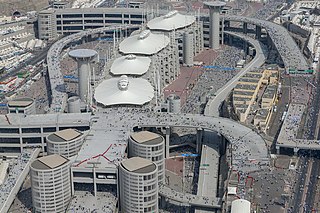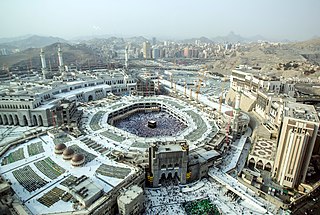
Mecca is the capital of Mecca Province in the Hejaz region of western Saudi Arabia and the holiest city in Islam. It is 70 km (43 mi) inland from Jeddah on the Red Sea, in a narrow valley 277 m (909 ft) above sea level. Its last recorded population was 2,385,509 in 2022. Its metropolitan population in 2022 is 2.4 million, making it the third-most populated city in Saudi Arabia after Riyadh and Jeddah. Around 44.5% of the population are Saudi citizens and around 55.5% are foreigners from other muslim countries. Pilgrims more than triple the population number every year during the Ḥajj pilgrimage, observed in the twelfth Hijri month of Dhūl-Ḥijjah. With over 10.8 million international visitors in 2023, Mecca was one of the 10 most visited cities in the world.

The Stoning of the Devil is part of the annual Islamic Hajj pilgrimage to the holy city of Mecca in Saudi Arabia. During the ritual, Muslim pilgrims throw pebbles at three walls, called jamarāt, in the city of Mina just east of Mecca. It is a symbolic reenactment of Ibrahim's hajj, where he stoned three pillars representing the Shaitan, and Muslims' temptation to disobey the will of Allah.

On 31 July 1987, during the Hajj pilgrimage in Mecca, a clash between Shia pilgrim demonstrators and the Saudi Arabian security forces resulted in the death of more than 400 people. The event has been variously described as a "riot" or a "massacre". It developed from increasing tensions between Shia Iran and Sunni Saudi Arabia since the 1979 Iranian Revolution. Since 1981, Iranian pilgrims have held a political demonstration against Israel and the United States every year at Hajj, but in 1987, a cordon of Saudi police and the Saudi Arabian National Guard sealed part of the planned demonstration route, resulting in a confrontation between them and the pilgrims. This escalated into a violent clash, followed by a deadly stampede.
The 2006 Hajj stampedeor crush resulted in the deaths of 363 pilgrims on 12 January 2006 during the Hajj in Mecca. It took place on Jamaraat Bridge around 1pm on 12 January 2006, the fifth and final day of the Hajj. Between two and three million pilgrims attended the Hajj in 2006. Earlier, on 5 January at least 76 pilgrims died when a hostel collapsed in Mecca.

Mina, also known as Muna, and commonly known as the "City of the Tents" is a valley located 8 kilometres southeast of the city of Mecca, in the district of Masha'er, Province of Makkah in the Hejazi region Saudi Arabia. Covering an area of approximately 20 km2 (7.7 sq mi), Mina incorporates the tents, the area of Jamarat, and the slaughterhouses just outside the tents.

The Jamaraat Bridge is a pedestrian bridge in Mina, Saudi Arabia, near Makkah used by Muslims during the Hajj ritual Stoning of the Devil. The purpose of the bridge is to enable pilgrims to throw stones at the three jamrah pillars either from the ground level or from the bridge. Jamaraat is the plural of jamraah, the Arabic term for each of the pillars involved in the stoning ritual. It literally means a small piece of stone or a pebble.

Hajj is an annual Islamic pilgrimage to Mecca, Saudi Arabia, the holiest city for Muslims. Hajj is a mandatory religious duty for Muslims that must be carried out at least once in their lifetime by all adult Muslims who are physically and financially capable of undertaking the journey, and of supporting their family during their absence from home.

The 2009 Saudi Arabian floods affected Jeddah, on the Red Sea (western) coast of Saudi Arabia, and other areas of Makkah Province. They have been described by civil defence officials as the worst in 27 years. As of 3 January 2010, some 122 people had been reported to have been killed, and more than 350 were missing. Some roads were under a meter of water on 26 November, and many of the victims were believed to have drowned in their cars. At least 3,000 vehicles were swept away or damaged. The death toll was expected to rise as flood waters receded, allowing rescuers to reach stranded vehicles.

Masjid al-Haram, also known as the Sacred Mosque or the Great Mosque of Mecca, is a mosque enclosing the vicinity of the Kaaba in Mecca, in the Mecca Province of Saudi Arabia. It is among the pilgrimage sites associated with the Hajj, which every Muslim must perform at least once in their lives if able. It is also the main site for the performance of ʿUmrah, the lesser pilgrimage that can be undertaken any time of the year. The rites of both pilgrimages include circumambulating the Kaaba within the mosque. The Great Mosque includes other important significant sites, such as the Black Stone, the Zamzam Well, Maqam Ibrahim, and the hills of Safa and Marwa.

Indonesia and Saudi Arabia established diplomatic relations in 1950. Relations are particularly important because Saudi Arabia is the birthplace of Islam, and Indonesia is home to the world's largest Muslim population; both are Muslim majority countries. Economy and trade relations are also particularly important, especially on oil (energy) and human resources sectors. Saudi Arabia has an embassy in Jakarta, while Indonesia has an embassy in Riyadh and a consulate in Jeddah. Both countries are members of the Organisation of Islamic Cooperation and G-20 major economies.

The hajj is a pilgrimage to Mecca performed by millions of Muslims every year, coming from all over the Muslim world. Its history goes back many centuries. The present pattern of the Islamic Hajj was established by Islamic prophet Muhammad, around 632 CE, who reformed the existing pilgrimage tradition of the pagan Arabs. According to Islamic tradition, the hajj dates from thousands of years earlier, from when Abraham, upon God's command, built the Kaaba. This cubic building is considered the most holy site in Islam and the rituals of the hajj include walking repeatedly around it.
The following lists events that happened during 2015 in the Kingdom of Saudi Arabia.

A crawler crane collapsed over the Masjid al-Haram in Mecca, Saudi Arabia, around 5:10 p.m. on 11 September 2015, killing 111 people and injuring 394 others. The city was preparing for the Hajj pilgrimage. The collapse has been cited as the deadliest crane collapse in history, with the previous most deadly incident being the collapse of a construction crane in New York City in 2008, killing seven people.

On 24 September 2015, a fatal crowd crush resulted in the death of more than 2,000 individuals, many of whom were suffocated or crushed, during the annual Hajj pilgrimage in Mina, Mecca, Saudi Arabia, making it the deadliest Hajj disaster in history. Estimates of the number of dead vary: the Associated Press reported 2,411 dead, while Agence France-Presse reported 2,236 killed. Based on the total of the individual national reports cited in the table below, at least 2,431 people died. The government of Saudi Arabia officially reported two days after the event that there had been 769 deaths and 934 injured. These figures remained official at the time of the next year's Hajj and were never updated. The largest number of victims were from Iran, followed by Mali and Nigeria.
On 3 July 1990, 1,426 people were suffocated and trampled to death in a crowd crush or stampede event in a tunnel near Mecca during the Hajj.
The 1994 Hajj stampede resulted in the deaths of at least 270 pilgrims on 23 May 1994 during the Hajj in Mecca during the Stoning of the Devil ritual.
The 1998 Hajj stampede resulted in the deaths of at least 118 pilgrims on 9 April 1998 during the Hajj in Mecca during the Stoning of the Devil ritual on Jamaraat Bridge.
The 2004 Hajj stampede resulted in the deaths of at least 251 pilgrims on 1 February 2004 during the Hajj in Mecca. The incident took place during the ritual stoning of three pillars in the Mina valley, close to Mecca, on the final day of Hajj ceremonies. More than 200 people were injured, and the incident became the worst tragedy during the Hajj since 1990.

Bilkisu Yusuf, also known as Hajiya Bilkisu Yusuf,, was a Nigerian journalist, columnist and editor for prominent newspapers in Abuja, Kano and Kaduna, Nigeria. She is known in Nigeria for being the first woman to direct a national newspaper operation and served as editor for two more. She was a Hausa, Muslim, feminist, of Yoruba descent and advocate for interfaith society, who was known for being an adviser to the Nigerian President on International Affairs and the founding of NGOs, such as Women In Nigeria (WIN) and the Federation of Muslim Women's Association (FOMWAN). Yusuf was killed in the 2015 Mina stampede while on Haj in Mecca, Saudi Arabia.

The COVID-19 pandemic affected the 2020 Hajj (pilgrimage), which is the fifth pillar of the Five Pillars of Islam, where millions of Muslims from around the world visit Mecca and Medina every year during Hajj season for a week. Over 2,400,000 pilgrims attended Hajj in 2019. Due to the highly contagious nature of COVID-19 in crowded places, various international travel restrictions, and social distancing recommendations, the Ministry of Hajj and Umrah advised Muslims to postpone their pilgrimage until the pandemic was mitigated. However, in June 2020, the Ministry opened up Hajj to people of all nationalities residing in Saudi Arabia, with foreigners still banned from attending to ensure pilgrims' safety and prevent the transmission of COVID-19.

















